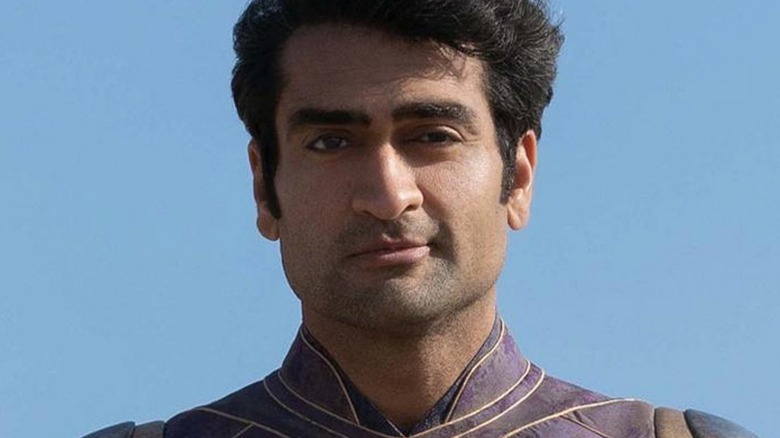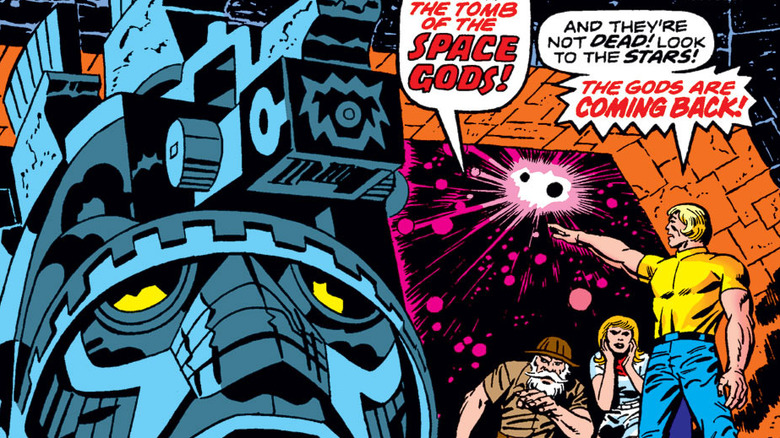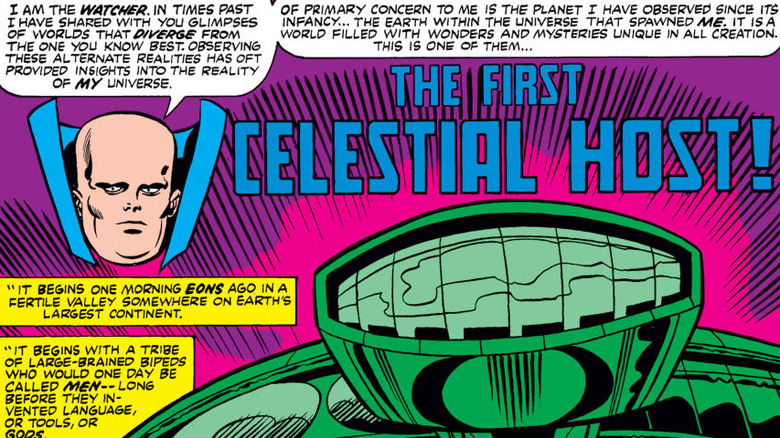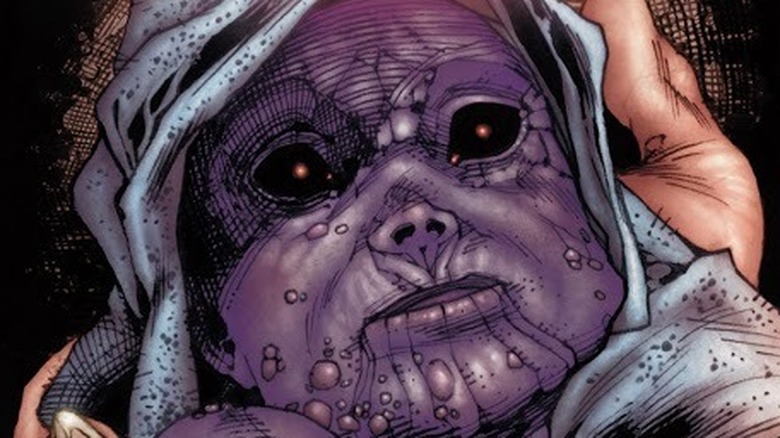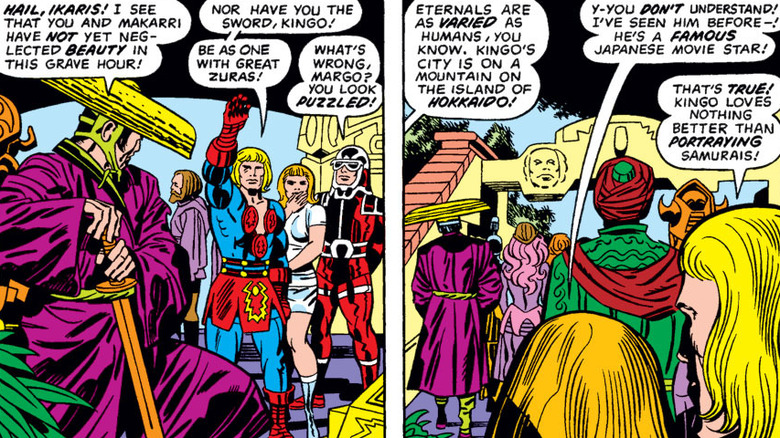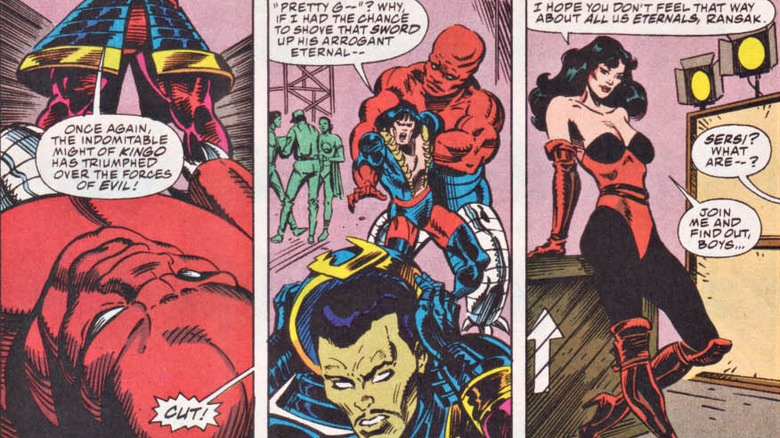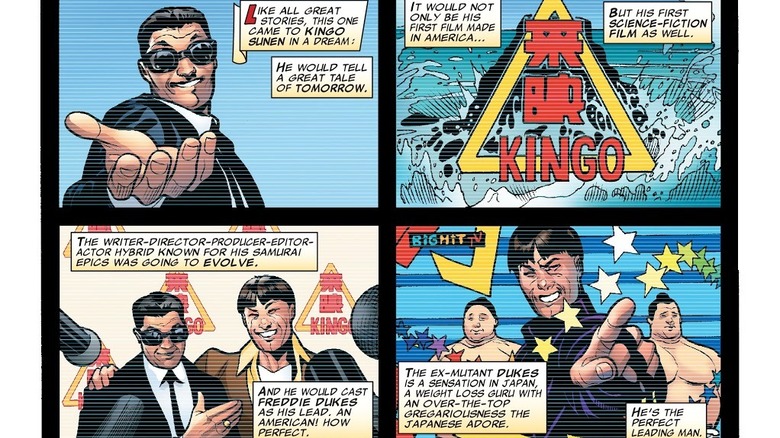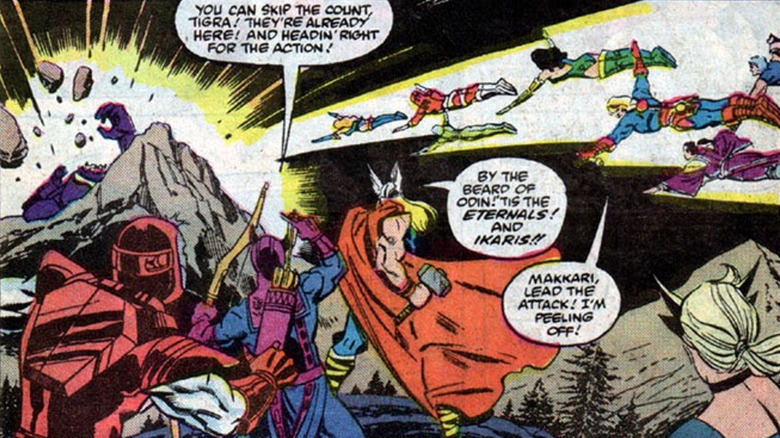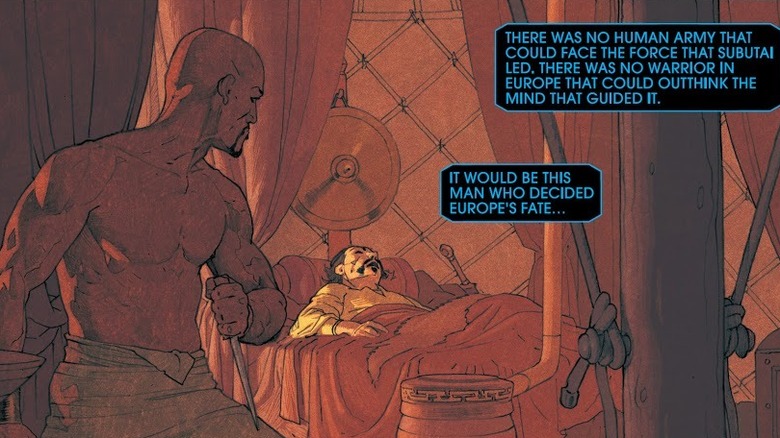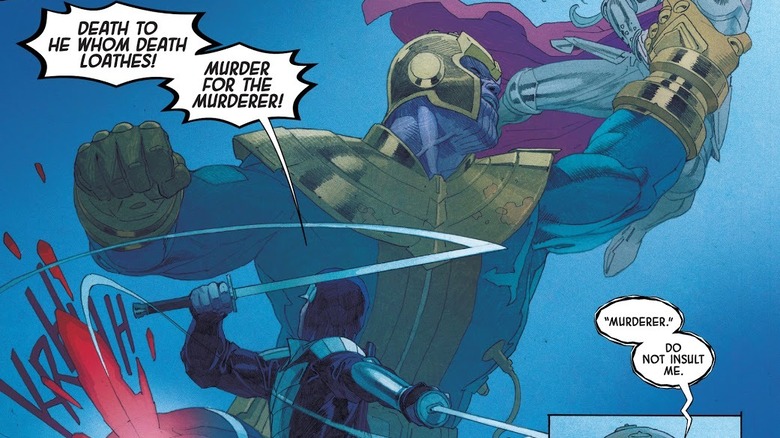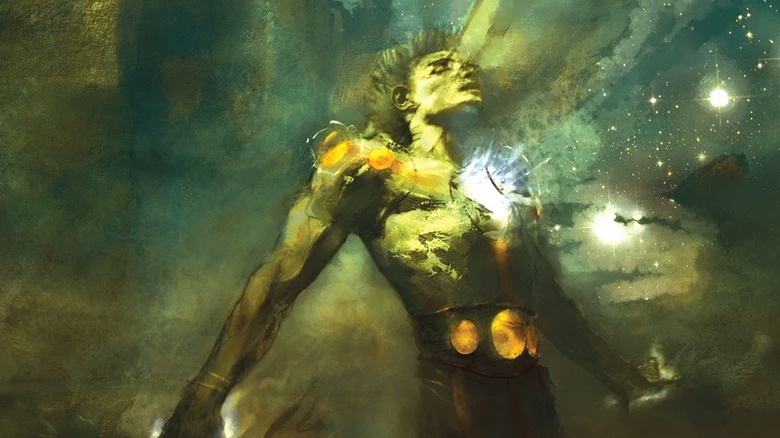The Eternals: Things Only Comic Book Fans Will Know About Kingo
When Pakistani-American actor and comedian Kumail Nanjiani appears as Kingo Sunen in director Chloé Zhao's "Eternals," not only will it offer an interesting inversion on the traditional superhero formula, since Kingo is a global celebrity in his civilian identity who seeks to keep his superheroic deeds hidden from the world, but it will also present an intriguing blend of comics-faithful traits and cinematic riffs on the character.
In both the comics and the film, Kingo is a big-screen star who hails from Asia, but while Nanjiani's Kingo performs in Bollywood musicals, the Kingo introduced by "Captain America" co-creator Jack Kirby appeared in martial arts movies filmed in his native Japan. Likewise, while Kingo has tended to serve as the sober voice of reason in the comics, Nanjiani told Men's Health that his take on Kingo was inspired by Bruce Willis as the wisecracking John McClane in "Die Hard."
You're about to meet him in the Marvel Cinematic Universe, so get to know Kingo Sunen in the Marvel Comics Universe.
The Eternals were inspired by ancient aliens
Writer-artist Jack Kirby displayed his fetish for fusing ancient cultural mythology with star-spanning sci-fi futurism from the moment he depicted Marvel Comics' version of the Norse God of Thunder, Thor, as hailing from an Asgard whose technology was sufficiently advanced to be indistinguishable from magic (to paraphrase Arthur C. Clarke).
Five years after he created the outer space-dwelling New Gods for DC Comics in 1971, Kirby returned to Marvel, but he still had a hankering for epic sagas about godlike aliens. So, he created the "Eternals" for Marvel in 1976, and used them to suggest that many of the deities, mythological beings, and legendary heroes from centuries past were inspired by extraterrestrial visitors to our planet during those bygone eras.
At the end of July 1976's "The Eternals" #1, Kirby devoted an entire text essay to speculating whether "super-beings" and "so-called Gods" had actually influenced human history in reality, as many pop culture storytellers were wondering in the wake of Erich von Däniken's 1968 "creative history" book, "Chariots of the Gods?"
If you're thinking this maybe sounds familiar, not only did the original 1978-79 "Battlestar Galactica" TV series borrow heavily from such "ancient astronaut" theories — see its opening narration about how "life here began out there, far across the universe" — but so has Giorgio Tsoukalos, the wild-haired, much-memed disciple of von Däniken who appears in the "Ancient Aliens" TV series.
Agent Mobius brought the Eternals into the MCU
"Eternals" debuts in November of 2021, just a few months after the "Loki" and "What If...?" series on Disney+ showed us how the fictional histories of these characters and their shared universes can be changed.
In "Loki," the Time Variance Authority's Agent Mobius (played by Owen Wilson) was based on the comic book character Mobius M. Mobius, who was created in turn by writer-artist Walt Simonson in 1991 in tribute to his boss, Mark Gruenwald, then the executive editor of Marvel Comics (Wilson's mustache was even grown and trimmed to resemble Gruenwald's).
Gruenwald cared so much about maintaining (and, in some cases, correcting) the continuity of the Marvel Comics Universe that he created "The Official Handbook of the Marvel Universe" in 1982, not long after he was joined by writer Peter Gillis and writer-editor Ralph Macchio (not the "Karate Kid" you're thinking of) in penning an important backup feature that ran through "What If...?"#23-30.
Later collected as "Eternals: Secrets from the Marvel Universe" in 2019, this eight-part serial feature turned out not to be a "What If...?" story at all, since it retold the origins and subsequent histories of the previously isolated Eternals as taking place on Earth-616, aka Marvel Comics' equivalent of the MCU's "the sacred timeline."
Thanos and Kingo are distant relatives
A million years ago, the cosmic beings known as the Celestials conducted genetic experiments on Earth that created both the Eternals and their enemies, the Deviants, as evolutionary offshoots of the human race. While the Deviants multiplied wildly, the Eternals exercised strict control over their own population numbers, a status quo that endured through a civil war over the Eternals' code of non-interference with humanity, until another schism erupted over the Eternals' reproduction.
In both conflicts, the majority of Eternals retained the old traditions, while the defeated insurgents were exiled to the outer reaches of our solar system. Just as the Eternal Uranos, who'd wanted to dominate Earth, was banished to the planet Uranus, the Eternal A'Lars, who'd wanted to expand the Eternals' population, adopted the title "Mentor" and joined Sui-San, the sole survivor of Uranos' followers, in settling Saturn's moon of Titan.
Although this colony of "Titans," led by Mentor and Sui-San, was initially successful, their doom came with one of the couple's sons, who fell prey to a genetic predisposition known among the Eternals as Deviant Syndrome. When Sui-San saw her son born with purple skin and a massive body, she went mad and tried (and failed) to kill him. Thus, like all the Eternals, Kingo can claim the "Mad Titan," Thanos, as a cousin of sorts (not that he would want to).
Kingo took a while to become a recurring character
In the original 20-issue "Eternals" series that Jack Kirby wrote and drew for Marvel Comics, Kingo appeared in only one issue, "The Eternals" #11, in which he featured in four panels of artwork across two pages. Kirby's signature style of exposition-dense dialog briskly outlined Kingo Sunen's background as a 16th-century samurai whose city sits on a mountain in the Japanese island prefecture of Hokkaido, and who since gained fame in Japanese movies by using his centuries-honed sword-fighting skills, as well as his first-hand historical experiences with actual samurai, to portray them on screen.
For the next eight years, that was it for Kingo Sunen, who didn't even appear in the Eternals' serialized integration into the Marvel Comics Universe that ran in "What If...?" from 1980 through 1981. Writers Peter Gillis and Walt Simonson corrected that oversight in their 12-issue 1985 "Eternals" miniseries, in which Kingo appeared in every issue except #2.
Kingo spends most of the miniseries filling out its crowd scenes, but he's featured in "The Eternals" #3, which shows him filming a scene from "Revenge of the Teenage Mutant Ninja Vampires," while also mentoring his handsome, hot-tempered young costar, Ransak, a covert Deviant who was outcast for his non-monstrous appearance. Kingo also wielded an impervious sword, forged by fellow Eternal and pacifistic weaponsmith Phastos, in "The Eternals" #4, before he came to blows with Ransak in issue #7.
He has secondhand connections with the Avengers
Kingo made a single-panel flashback appearance in "Avengers" #310 in November of 1989, when the Eternals — including Gilgamesh, who went by the title "The Forgotten One" at the time — fought Blastaar, a warlord of the Negative Zone who frequently sparred with the Fantastic Four. Gilgamesh had been recruited into the Avengers with issue #300 in February of 1989, as part of a lineup consisting of Mr. Fantastic and the Invisible Woman, as well as Thor and Captain America (then still calling himself the Captain). While that roster lasted only four issues, the Forgotten One remained officially on call until the Eternals' battle with Blastaar left him too injured to continue serving as an Avenger.
In his stead, fellow Eternal Sersi joined the Avengers in issue #314, leading to an era when Earth's Mightiest Heroes all wore uniformly ugly brown leather bomber jackets as part of their costumes. By "Avengers" #370, Sersi's Avengers teammates were swathed in hideously bland jackets — oh, and also captured and mind-controlled by Deviants — but since Sersi's fellow Eternals mistrusted her, she sought aid from the Deviant warlord Kro, who helped her assemble a "Delta Force" team of more well-intentioned Deviants.
Although Sersi made contact with Kingo, whom she found maintaining his prickly partnership with Ransak as they continued to make movies together, she came to recruit Ransak instead.
He's met a few mutants
Ransak upstaged Kingo again in "The New Eternals: Apocalypse Now" one-shot in 2000, which saw Kingo cameo in a single-panel crowd-shot. Meanwhile, Ransak was afforded an entire character arc of his own, as he endured (and recovered from) full-body radiation burns to reunite with the Eternals so that they could stop the millennia-old mutant supremacist Apocalypse from inciting a war of mutually assured destruction between the Deviants and human society.
Ransak was inducted into the Eternal leader Ikaris' superhero team, the New Breed, while Kingo wouldn't resurface until "Uncanny X-Men" #500 in September of 2008, whose opening prologue was wholly devoted to "The Extraordinary Dream of Kingo Sunen." Kingo, having shed his samurai hairstyle and gained enough weight to resemble post-ponytail Steven Seagal, is shown promoting not only his first film made in America, but also his first science fiction film. For the movie, Kingo cast the newly svelte Freddie Dukes, aka the once-morbidly obese Brotherhood of Evil Mutants member known as the Blob, as his lead actor (Dukes was among the mutants depowered by the Scarlet Witch on M-Day, the centerpiece of the 2005 "Decimation" crossover event).
Kingo's movie was set to be shot in San Francisco, where the "Dreaming Celestial" Tiamut laid mostly dormant in Golden Gate Park, but it turned out that Kingo was being manipulated by a supervillainous genetic engineer, the High Evolutionary, who used the Dreaming Celestial to restore Magneto's mutant powers, which were also lost during M-Day.
He even hung out with the West Coast Avengers
San Francisco was not the first time Kingo tangled with Tiamut, as the Deviant priest-lord Ghaur sought to harness the power of the Dreaming Celestial in the final issue of the 1985-86 "Eternals" miniseries, drawing the attention of Earth's Mightiest Heroes in the process. Sersi was a social butterfly in the Marvel Comics Universe even before she joined the Avengers, hosting a catered dinner party in her Manhattan apartment in May 1986's "Eternals" #8, whose well-dressed guests included Hercules, Namor the Sub-Mariner, Avengers butler Edwin Jarvis, and Warren Worthington III, aka Angel of the original X-Men.
But it wasn't until "Eternals" #12 that we saw Sersi, Kingo, and the rest of the Eternals fighting alongside Iron Man and his Avengers West Coast teammates Hawkeye, Mockingbird, Tigra, and (ugh) Wonder Man — with Thor flying out to lend a hand, and Captain America staying put on the East Coast to coordinate the military's response with the White House — after a gigantic Ghaur landed in the Diablo mountain range of California and began tearing the mountains apart to uncover the crypt of the Dreaming Celestial.
While the Avengers banded together to attack Ghaur physically, the Eternals joined their will and intelligence into a "Uni-Mind," a single powerful entity made of light, mind, and pure energy, to free Ghaur's mind and will from the control of Tiamut, who was forcing Ghaur to unearth the crypt of the Dreaming Celestial.
Kingo nearly changed history by killing one man
Most of Kingo's backstory was revealed in the latest "Eternals" series, which Marvel Comics began publishing in 2021. The 1985-86 "Eternals" miniseries established that Kingo was one of a small band of Eternals from Earth who chose to stay at home during a period when the rest of the Eternals explored outer space. However, it wasn't until Disney greenlit an "Eternals" film that Marvel decided to flesh out how Kingo had spent his centuries living among humanity.
When Ögedei Khan, son of Genghis Khan, sent his general Subutai to invade Europe with the Mongols in 1242 AD, Kingo learned that the power-hungry Eternal Druig was marching with them, and came to believe that Druig was controlling the Mongols' minds. However, when Kingo confronted him, Druig revealed that he had nothing to do with the rise of the Mongol Empire, but instead wanted to study their methods, and suggested that Kingo should assassinate Subutai to halt the Golden Horde's invasion of Europe.
Although Kingo crept into Subutai's tent with a knife in his hand, he ultimately proved too afraid of becoming like Druig to strike the killing blow. Ironically, when Subutai and the Mongol Horde returned home the next day to select a new ruler (Ögedei Khan had died of a stroke), Druig speculated that finding Subutai murdered in his bed could have compelled the Horde to defy their orders to return home, and instead continue their invasion of Europe.
Kingo helped defeat Thanos, but uncovered a terrible truth in the process
In addition to lending his sword to the Eternals' recurring tussles with Deviants and Celestials, Kingo fought Thanos after the Mad Titan was resurrected by a traitor in the Eternals' ranks. Thanos not only killed several Eternals, including the Prime Eternal Zuras, but also sabotaged the Eternals' machines of resurrection, which in turn threatened the Earth's biosphere.
Kingo teamed with fellow Eternal Thena to track down the traitor, working through a suspect list that started with Kingo's old foe Druig, who attempted a psychic whammy on Thanos as Kingo and Thena traded blows with the Mad Titan, before moving on to Gilgamesh. Ultimately, Phastos was identified as the culprit.
The Eternals were able to overwhelm Thanos, but when they remonstrated with Phastos, he revealed that each time that an Eternal resurrects, it costs a human being their life, and deactivating the resurrection machines would endanger the Earth. This revelation came after Ikaris gave his life (and was resurrected) to repair the machines.
When the Eternals who'd learned this truth informed a resurrected Zuras of their ethical quandary, he reassured them they would arrive at a solution by convening a Uni-Mind, but it was the cynical Sersi — who'd already known the cost of their immortality — who pointed out that most other Eternals are unlikely to care about the deaths of humans, whose life spans are already so much shorter than their own.
Where you won't find Kingo
While Kingo Sunen appears in "Eternals" (Vol. 1) in 1977, "Eternals" (Vol. 2) from 1985-86 and "Eternals" (Vol. 5) in 2021, you won't find him in any of the seven issues of "Eternals" (Vol. 3) from 2006-07, nor in any of the nine issues of "Eternals" (Vol. 4) from 2008-09.
As of 2021, Kingo has appeared in close to two dozen individual comic book issues since his debut in 1977, and while some takes on his fellow Eternals, such as the seven-issue "Eternals" (Vol. 3) by writer Neil Gaiman and artist John Romita Jr., have earned high praise, radical reinterpretations such as writer Chuck Austen's two issues of "The Eternal," for the Marvel MAX Comics adults-only imprint, have fared more poorly.
As always, let the buyer beware, but rest assured that, if Chloé Zhao's "Eternals" film succeeds at the box office, and especially if Kumail Nanjiani's portrayal of the character becomes a fan favorite, we're that much more likely to see more stories about Kingo Sunen from Marvel Comics.
